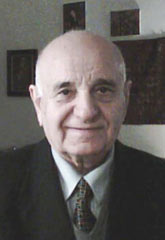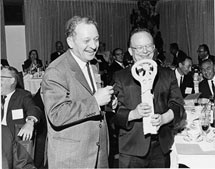
Handy Links
SLAC News Center
SLAC Today
- Subscribe
- Archives: Feb 2006-May 20, 2011
- Archives: May 23, 2011 and later
- Submit Feedback or Story Ideas
- About SLAC Today
SLAC News
Lab News
- Interactions
- Lightsources.org
- ILC NewsLine
- Int'l Science Grid This Week
- Fermilab Today
- Berkeley Lab News
- @brookhaven TODAY
- DOE Pulse
- CERN Courier
- DESY inForm
- US / LHC
SLAC Links
- Emergency
- Safety
- Policy Repository
- Site Entry Form

- Site Maps
- M & O Review
- Computing Status & Calendar
- SLAC Colloquium
- SLACspeak
- SLACspace
- SLAC Logo
- Café Menu
- Flea Market
- Web E-mail
- Marguerite Shuttle
- Discount Commuter Passes
-
Award Reporting Form
- SPIRES
- SciDoc
- Activity Groups
- Library
Stanford
Around the Bay
November Visit Continues a Longstanding Tradition of Cross-borders Science and Friendship
Professor Robert Avagyan and Director Ashot Chilingarian from the Yerevan Physics Institute in Armenia visited SLAC National Accelerator Laboratory this month to tour the lab and meet with SLAC and Stanford University physicists. The visit is the latest in a long-standing friendship between SLAC and YerPhI. Over time both institutions have continued exchanging ideas and opinions for mutual benefit, but the relationship began with two prominent high-energy physicists mid-last century.
"There were only a few accelerators in the world," Avagyan said during his visit to SLAC. "So of course the physicists and people that had leadership at these facilities knew each other and discussed the future of physics and accelerators."
Pief Panofsky, director of SLAC from 1961–1984 and Artem Alikhanian, founder and director of YerPhI from 1943–1973, had a lot in common. Both were the first directors of their respective institutions, both built electron accelerators, and both were known as experienced experimentalists. Similarities like these sparked a friendship that reached beyond discussions of physics.
Archived correspondence from 1967 documents Panofsky's efforts to arrange visits for two prominent Armenian experimental physicists to spend a year using SLAC facilities for their research. After learning about the difficulties that Soviet physicists had securing approval and visas from the United States government, Panofsky sent requests to Washington, DC, asking the Office of Science and Technology to re-evaluate the handling of foreign scientific visitors to the United States.
Later that year, at SLAC's dedication banquet, Alikhanian presented Panofsky with a statue by world-renowned Armenian sculptor Arto Chakmakjian, the first of two works by Chakmakhian that he would give SLAC. A more personal gift came in 1969. In a letter about YerPhI borrowing a SLAC computer, Alikhanian congratulated Panofsky on having recently become a grandfather and wrote that he was sending a 5000-year-old artifact—a jar excavated in Armenia—as a gift and symbol of longevity for Panofsky's newborn granddaughter.
At a 1970 conference in Kiev, then the capital of the Ukranian Republic in the Soviet Union, Alikhanian introduced Avagyan to Panofsky. The two had similar interests within the field of high-energy physics and in 1978 Avagyan came to SLAC to propose an experiment using SLAC's linear accelerator to study radiation emitted by positrons, the anti-particle of electrons, zipping through crystals at nearly the speed of light.
"Panofsky was very much interested in my experiment and he approved my proposal," Avagyan said. But as a citizen of a Soviet republic, Avagyan could spend only one year in the United States, meaning his experiment needed to be completed in record time. He requested of Panofsky an increase in the intensity of the electron beam so that he might finish in under a year. "Panofsky gave me that possibility with a more intense beam and a team of excellent physicists, and I finished just in time," Avagyan said.

Thirty years and four SLAC directors later, Avagyan, who has been a faculty member at YerPhI since 1984, is still returning to the American lab. He and Chilingarian, who has been director of YerPhI since 2008 and head of the Cosmic Ray Division since 1993, were keen to see SLAC's newest facility, the Linac Coherent Light Source, and learn about its capabilities. "It is really amazing that it is possible to see the dynamics of biological processes, which has become possible now with the facility," Avagyan said.
YerPhI is also looking to expand its facilities. The institute already contains underground laboratories and large above-ground arrays at high elevations on Mt. Aragats, as well as a small electron accelerator and synchrotron, which uses electrons stored in a ring to produce light for high-energy physics research. Famous for its cosmic-ray research, which began in 1943, the institute is currently investigating space weather—how events in space affect weather on Earth. But now, YerPhI is once again looking toward man-made accelerators, this time for medical research.
"In Armenia, the Yerevan Physics Institute was selected as a site where nuclear medicine will be developed," Chilingarian said. The institute will soon receive a cyclotron from Belguim, enabling YerPhI to begin their research. "This will be extremely important for Armenian medicine," Chilingarian added.
Just as it was for Alikhanian and Panofsky, sharing technical expertise could be very beneficial for both labs now. While at SLAC, the visiting Armenian scientists took the opportunity to speak with physicists, including Tor Raubenheimer, head of accelerator research at SLAC, about small-scale scientific accelerators as well as various options for accelerators for industry or medical isotope production.
Isotopes are atoms that differ by the number of neutrons they contain, and many are radioactive. Two types of isotopes are particularly interesting for medical diagnostics. The first emits gamma radiation and can be used to label molecules for imaging with medical equipment. In the second type, atoms emit positrons, which are used for Positron Emission Tomography, more commonly known as PET scans. YerPhI will look to produce PET isotopes, but is interested in options for production of gamma isotopes as well.
Complementary skill sets, including SLAC's accelerator know-how and YerPhI's talented physical chemists, will enable new medical isotope research at YerPhI. Armenian chemists could expertly separate isotopes, a known technological challenge in nuclear medicine, but SLAC accelerator physicists may be able to help devise additional methods for isotope production. "The experience and ideas from physicists at SLAC will make our projects better," Chilingarian said.
While in the area, Chilingarian also met with researchers in the Stanford University Electrical Engineering department and gave seminars at the Astrophysics department about naturally occurring accelerators in space. Chilingarian's recent research at YerPhI detected massive particle acceleration in the low atmosphere during thunderstorms. "I was very happy that a lot of young scientists came," he said. "That is one of the important things we have to take from SLAC, that it always has good connections with the university and there are always young scientists at SLAC.
"It is a priority of our institute and government to give a good education to physicists," Chilingarian continued. "We have to start an education program at the Yerevan Physics Institute." The director said he wants to bring students to YerPhI laboratories for increased hands-on training because learning accelerator physics should include actively participating in a laboratory setting in addition to listening to lectures.
With strong training programs, Avagyan and Chilingarian said they hope to see the relationship between SLAC and YerPhI continue in the future. "We hope to have a new generation of physicists that will continue Alikhanian and Panofsky's friendship," Chilingarian said
—Lauren Knoche
SLAC Today, November 24, 2009
